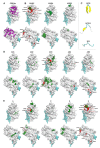Mechanisms of Hepatitis C Virus Escape from Vaccine-Relevant Neutralizing Antibodies
- PMID: 33804732
- PMCID: PMC8004074
- DOI: 10.3390/vaccines9030291
Mechanisms of Hepatitis C Virus Escape from Vaccine-Relevant Neutralizing Antibodies
Abstract
Hepatitis C virus (HCV) is a major causative agent of acute and chronic hepatitis. It is estimated that 400,000 people die every year from chronic HCV infection, mostly from severe liver-related diseases such as cirrhosis and liver cancer. Although HCV was discovered more than 30 years ago, an efficient prophylactic vaccine is still missing. The HCV glycoprotein complex, E1/E2, is the principal target of neutralizing antibodies (NAbs) and, thus, is an attractive antigen for B-cell vaccine design. However, the high genetic variability of the virus necessitates the identification of conserved epitopes. Moreover, the high intrinsic mutational capacity of HCV allows the virus to continually escape broadly NAbs (bNAbs), which is likely to cause issues with vaccine-resistant variants. Several studies have assessed the barrier-to-resistance of vaccine-relevant bNAbs in vivo and in vitro. Interestingly, recent studies have suggested that escape substitutions can confer antibody resistance not only by direct modification of the epitope but indirectly through allosteric effects, which can be grouped based on the breadth of these effects on antibody susceptibility. In this review, we summarize the current understanding of HCV-specific NAbs, with a special focus on vaccine-relevant bNAbs and their targets. We highlight antibody escape studies pointing out the different methodologies and the escape mutations identified thus far. Finally, we analyze the antibody escape mechanisms of envelope protein escape substitutions and polymorphisms according to the most recent evidence in the HCV field. The accumulated knowledge in identifying bNAb epitopes as well as assessing barriers to resistance and elucidating relevant escape mechanisms may prove critical in the successful development of an HCV B-cell vaccine.
Keywords: B-cell vaccine; antibody escape; hepatitis C virus; virus neutralization.
Conflict of interest statement
The authors declare no conflict of interest.
Figures




References
-
- World Health Organization Hepatitis C. [(accessed on 17 March 2021)]; Available online: https://www.who.int/news-room/fact-sheets/detail/hepatitis-c.
-
- Robertson B., Myers G., Howard C., Brettin T., Bukh J., Gaschen B., Gojobori T., Maertens G., Mizokami M., Nainan O., et al. Classification, nomenclature, and database development for hepatitis C virus (HCV) and related viruses: Proposals for standardization. Arch. Virol. 1998;143:2493–2503. doi: 10.1007/s007050050479. - DOI - PubMed
Publication types
LinkOut - more resources
Full Text Sources
Other Literature Sources

